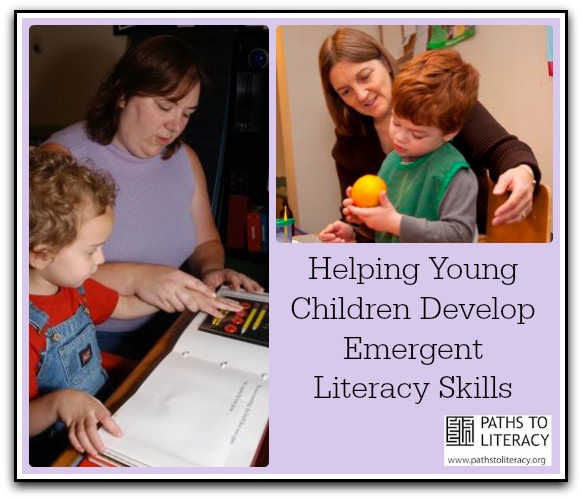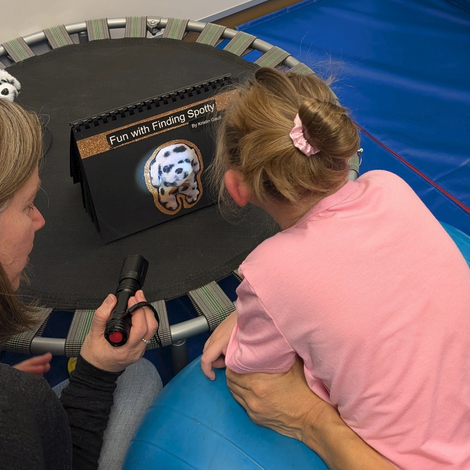How can I help my child to develop literacy skills?
- Establish routines
- Experiential learning
- Meaningful activities
- Read aloud
- Exposure to reading and writing
- Evidence-based recommended practices
Establish predictable routines to encourage children to learn to anticipate events.
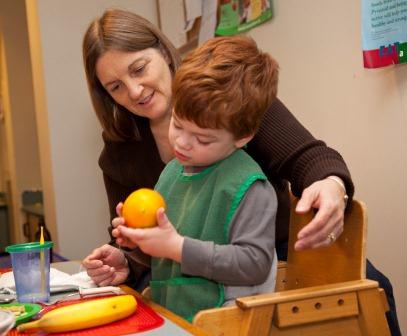 When routines are established, children begin to learn about objects and vocabulary associated with certain activities. Active participation in all steps of a routine can reinforce concepts and language skills. Routines can also help a child to develop sequencing skills (first/then; start/finish), and some tasks can be arranged in left to right order, such as setting the table, laying out clothes, or arranging materials for any activity.
When routines are established, children begin to learn about objects and vocabulary associated with certain activities. Active participation in all steps of a routine can reinforce concepts and language skills. Routines can also help a child to develop sequencing skills (first/then; start/finish), and some tasks can be arranged in left to right order, such as setting the table, laying out clothes, or arranging materials for any activity.
Provide concrete language-embedded experiences.

Children who are blind or visually impaired need the opportunity to experience things through hands-on activities that are meaningful and fun. As mentioned above, they will often need specific instruction because of the lack of access to information through incidental learning. For example, a book about a farm will be much more meaningful if the child has first had a chance to visit an actual farm, touch different kinds of animals, touch their fur or feathers, feel how big they are, listen to their calls (moo, neigh, quack), examine what they eat (hay, grain), and learn about what they produce (e.g. milk, eggs, wool).
Create a communication-rich environment with meaningful activities in the natural context.
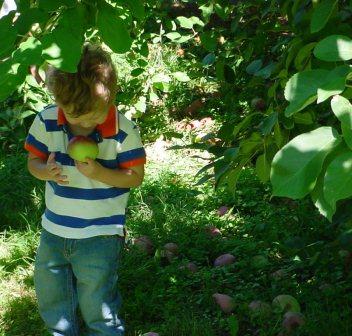 The development of a wide range of vocabulary and concepts are essential to success in literacy. Model appropriate language for your child throughout the day. For example, “Let’s put on your smooth rubber boots today. It’s raining and they will help keep your feet dry.” Or “Let’s put the cold milk in the red plastic cup. Can you help me pour it?” Just adding some adjectives (wet/dry, rough/smooth, big/little) and more detailed descriptions can help to expand a child’s vocabulary and to reinforce concepts.
The development of a wide range of vocabulary and concepts are essential to success in literacy. Model appropriate language for your child throughout the day. For example, “Let’s put on your smooth rubber boots today. It’s raining and they will help keep your feet dry.” Or “Let’s put the cold milk in the red plastic cup. Can you help me pour it?” Just adding some adjectives (wet/dry, rough/smooth, big/little) and more detailed descriptions can help to expand a child’s vocabulary and to reinforce concepts.
Read aloud!
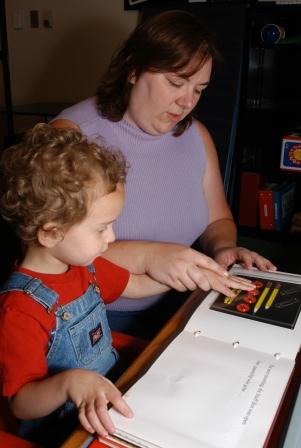 Many children benefit from reading aloud. It is a time for them to enjoy special individual attention, to reinforce language and concept development, and to work on book handling skills. In order for the experience to be pleasant and meaningful, however, it is important to follow a few basic tips.
Many children benefit from reading aloud. It is a time for them to enjoy special individual attention, to reinforce language and concept development, and to work on book handling skills. In order for the experience to be pleasant and meaningful, however, it is important to follow a few basic tips.
- Reading a book with a young child should be fun for both the adult and child.
- Choose a book that relates to the child’s own experiences.
- Read at a pace that is appropriate to the child.
- Provide props to supplement the illustrations. Concrete objects, movements, and sounds may all be helpful.
- Modify the book to meet a child’s individual needs and interests. Add texture, color, tactile cues, or anything to enhance the experience and make the book more accessible to the child.
Expose the child to reading and writing within the daily routine.
Include the child in the process of reading and writing lists, directions, recipes, menus, messages or letters to friends and family, and any other activities that occur within routine activities. Because they may not be able to observe you reading or writing, you will need to be creative in finding ways to make these activities accessible. For example, before going to the grocery store, ask the child to help you think of what things you might need to buy. Have him or her help you look in the refrigerator or cupboards to see the supply (e.g. “This carton of milk is almost empty! It feels light and I can hear it sloshing around in there. Let’s add it to our shopping list, so we’ll remember to buy more when we get to the store.”) Be sure to refer back to the list once you get to the store, and even check it when you get back home again, to be sure that you got everything on the list.
This article suggests a way to individualize literacy experiences for visually impaired students in order to promote meaningful reading and writing. It includes a list of global experiences and suggestions of how to use the essential literacy experiences for students with a visual impairment. A blank form of Sample Essential Literacy Experiences for the Visually Impaired Student can be downloaded; available in English and Spanish.
Move, Touch, Read is an informal collection of sample units by Wendy Drezek that provide simple techniques for adapting print books. It grows out of the belief that experiential learning can help children who are blind to develop concepts, motor skills, and an understanding of the world that are at the foundation of braille literacy skills. Beginning with movement and sensory-based experience, vocabulary and concepts are introduced or reinforced, and tactile symbols using real objects supplement each story with a hands-on component. Story boxes or props help to make each story more meaningful to the child through tactile exploration. Each unit includes an introduction, vocabulary, concepts, skills, symbols, and suggestions for movement, touch, and reading activities.
What are the evidence-based and recommended practices to facilitate emergent literacy?
“To facilitate emergent literacy in young children with disabilities, early interventionists should provide collaborative, family-centered support that is developmentally appropriate and based on evidence-based and recommended practices that result in functional outcomes within naturally occurring learning opportunities.”
— Early Intervention Training Center for Infants and Toddlers with Visual Impairments
Strategies and interventions to facilitate emergent literacy focus on the development of the six key components:
- oral language
- phonological awareness
- concept development
- knowledge of the conventions of print/braille and print/braille intentionality
- alphabetic knowledge
- rich literacy environments
Developmentally appropriate strategies and interventions that promote functional outcomes include:
- play
- routines-based literacy
- responsive literacy environments
- shared storybook reading (especially dialogic reading, storybook preview, and storybook sounds)
- storytelling, including decontextualized language
- dialogue/conversation.
To learn more, see the power point presentation What Is Emergent Literacy? from the Early Intervention Training Center for Infants and Toddlers With Visual Impairments, FPG Child Development Institute, 2005
Emergent Literacy Skills for Future Braille Readers
Young children must develop skills in a wide range of areas, including tactile, fine motor, listening & attention, concept, and book & story. This chart shows a variety of prerequisite skills and concepts that will help future braille readers to be successful.
